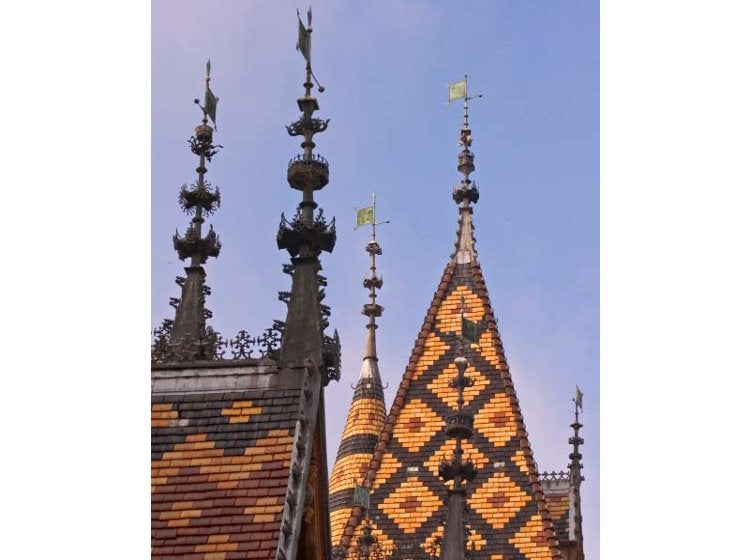
by Neil Beckett
As they assembled for the 149th Hospices de Beaune auction on Sunday November 15th, even the most astute and experienced among the Beaune négociant elite admitted to being unsure which way prices for the 2009 wines would go. The uncertainty was due to the adverse economic situation and the coincidence of an excellent but generous vintage-799 barrels were being offered by the Hospices de Beaune compared to 544 last year (up 47 percent).
Most of the observers who were prepared to stick their necks out predicted a fall in the average price per barrel of around one fifth. As Louis-Fabrice Latour, president of the Federation of Burgundy Wine Merchants, reminded the audience at a packed pre-sale press conference, prices have fallen for great vintages in the past, 1990 being a conspicuous recent example. In the event, however, rather than falling 20 percent, the average price rose by the same amount.
Record results
Emmanuelle Vidal-Delagneau, the business development director for Christie’s France, which has helped organize the sale for the past five years, said afterwards: “Tonight, the sale achieved a record total of ¤5,446,095 (£4,865,000 / $8,125,574), within a whisker of the all-time 2000 record, which was millennium-driven. Fierce bidding resulted from nearly 500 private and professional participants from all parts of the world, 40 percent of whom bought from afar by telephone, internet, or faxed bids.”
The sale featured 31 cuvées of red wine (654 barrels) and 13 of white wine (145 barrels). These together fetched ¤5,347,967. On top of this, the two “president’s barrels” (rather than the normal one) raised ¤90,000 / £80,397 / $134,280 for three charities: the Congrégation des Soeurs Hospitalières de Ste Marthe in Rwanda; Fondation Motrice, which funds research into cerebral palsy; and Restos du Coeur, which provides free meals and other forms of help to the poor. This year the wines were a Corton Grand Cru Cuvée Charlotte Dumay and a Meursault Premier Cru Charmes Cuvée Albert Grivault. They were bought by a group of négociants including Aegerter, Bichot, Boisset, Bouchard Père et Fils, Corton André, Drouhin, Faiveley, Jadot, and Louis Latour.
Returning to the more indicative prices fetched by the rest of the wines, the average price of the reds was sharply up, by 31.12 percent, while that for whites was slightly down, by 2.82 percent. Anthony Hanson MW, senior consultant for Christie’s International Wine Department, said, “The superb quality of the Hospices red wine cuvées in 2009 ensured that prices leaped upwards, and there were fierce battles for the greatest whites. The star white was Bâtard-Montrachet Cuvée Dames de Flandres [¤69,550 / £62,129 / $103,768 per barrel including taxes].
Record prices were set for Corton- Charlemagne Cuvée François de Salins [¤32,100 / £28,675 /$47,893] and Clos de la Roche Cuvée Cyrot-Chaudron [¤40,660 / £36,321 / $60,665].” Of the top ten lots, five were bought by private European buyers, four by Burgundy négociants, and one by a private Middle East buyer. Generally, it was private rather than trade buyers who seem to have pushed prices up, presumably on the strength of the positive reports of the vintage and the first tastings of the wines.
The vintage and the wines
The growing season and harvest were certainly promising. Hanson, a leading authority on Burgundy, said that the flowering was well under way by late May: “This was a great start for two reasons. Firstly, fine weather during the flowering allowed for well-formed bunches and regular grape-ripening, both factors of quality. Secondly, the early flowering led to an early harvest, allowing flexibility over individual start-dates, from plot to plot, as full ripening was completed.” After a wet second half of July, the weather in August and September was favorable, with above-average temperatures, 15 percent more sunshine hours, and 40 percent less rain than normal. Harvest conditions were almost perfect. “Some stiff breezes helped concentrate the juice in the grapes, and cool nights helped maintain those acidities which are essential to give wines natural freshness and balance,” Hanson concluded. The health and ripeness of the grapes are reported to be very close to the quality of 2005.
Although the wines were of course still very young at the pre-sale tasting, the reds in particular were exciting, indeed pleasant, to taste; normally they are much more raw, tannic, and woody, but Hospices régisseur Roland Masse insists that the vinification was as usual. If these wines were speaking the voice of the vintage, it is purringly seductive. While many of the whites seemed rather blowsy and heavy, this may have been more a function of harvest dates.
Effect on prices for 2007-2009
The Hospices prices still serve as an indication for the market as a whole. And if growers and négociants can be confident of good prices for their ’09s, it may, as Latour suggested, help them lower prices for the more sluggish ’07s and ’08s. According to Pierre-Henry Gagey, president of the Bureau Interprofessionnel des Vins de Bourgogne, some Burgundy buyers have been requesting reductions of 20-25 percent for these vintages. The latest statistics show exports down 29 percent in the year to September.
Sales of grands and premiers crus have been worst affected, with total sales to the US down 44 percent by value, though Latour hopes to end the year there down only 30 percent. He also believes that sales on the ground are probably holding up better than the shipment figures suggest, and may be down only 15-20 percent. Setting the decline in context, he said, “We’re not going back 25 years, only three. It’s not like the early ’90s.”






